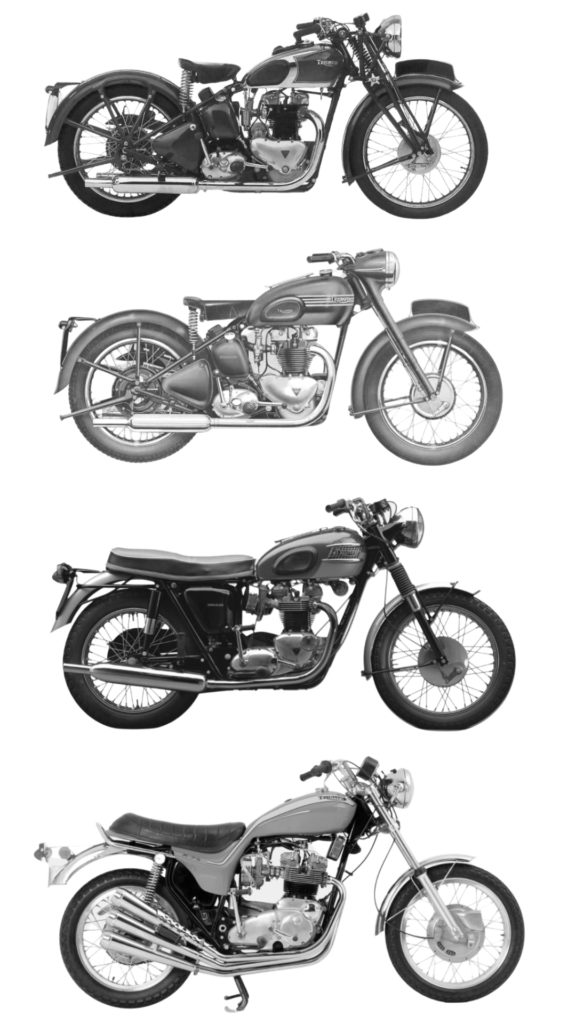Triumph Motorcycle History
Triumph motorcycle history began with the efforts of a young German entrepreneur by the name of Siegfried Bettmann. After settling in Britain in his early 20s, Bettmann worked in various short-term jobs before going into business for himself.
S. Bettmann & Co. was established in 1886 for the purpose of selling bicycles. The following year he changed the name to the Triumph Cycle Company. He took on a partner, Johann Schulte, and in 1889, with financial help from Schulte’s family began manufacturing bicycles, rather than merely selling them.
After Moving to their own facility in Coventry, they introduced their first motorcycle in 1902 – a bicycle with a 2.2 h.p. Minerva engine. At the time, numerous fledgling motorcycles outsourced their engines, rather than bear the expense of the necessary machinery and tooling to build them in-house. They started building their own engines in 1905.
During the first half of the twentieth century, Triumph grew exponentially in size, largely due to war production. By the end of WWI, they were the largest motorcycle manufacturer in the UK. The introduction of the Triumph Speed Twin in 1937 marked the beginning of a 30 year plus run of vertical twins of various displacement sizes.
Like its parent company, BSA, Triumph failed to anticipate the impact the new Japanese imports of the late 1960s would have on the motorcycle world. Honda and other Japanese bikes quickly became faster and more reliable than British bikes, with more features at substantially lower prices. While it can be argued that the new imports lacked the charisma of the Triumph Bonneville and its brothers, there was no denying their appeal from a cost standpoint. This lack of foresight, coupled with stagnated designs and high labor costs doomed the British motorcycle industry. Triumph was the last British motorcycle manufacturer to fail, closing its doors in August of 1983. Triumph motorcycle history would resume in 1987, When John Bloor purchased its manufacturing rights.
Triumph Speed Twin:
In 1937 Triumph introduced their 500cc Speed Twin. The bike was powered by a new engine type other British manufacturers would copy for decades to come. It was a vertical twin with both pistons rising and falling simultaneously in their cylinder bores. One piston would be on the intake stroke while the other was on the exhaust stroke. This resulted in a smoothness not present in the singles or V-twins of the day. Over the years, this configuration would be used successfully in engines of steadily increasing displacement.
Triumph Thunderbird:
The Triumph Thunderbird, manufactured from 1949 to 1966, was an enlarged version of the Speed Twin. At 650cc and 34 h.p., it was the bike to have during the early 1950s. The release of the movie “The Wild One” with Marlon Brando in 1953 had the same effect on Thunderbird sales as the later film “Dirty Harry” would have on Smith & Wesson 44 Magnum revolver sales. The bike had a rigid frame and a headlight nacelle that incorporated the speedometer and other instruments. Even after the release of higher performance dual carbureted models, the Thunderbird would remain popular as an everyday transportation machine.
Triumph Bonneville & Bonneville TT Special:
The Triumph Bonneville, named after the famous Bonneville Salt Flats, was manufactured from 1959 to 1974. The bike featured dual Amal Monobloc carburetors and other performance upgrades which increased top speed to a factory stated 115 mph. They were of pre-unit construction (separate engine and transmission) until 1973, when Triumph changed over to unit construction. on this and other models.
The TT Special was a more radical version of the Bonneville with higher compression pistons, larger 1 3/16” bore carburetors, upswept exhaust, and no lights. Intended for racing only, an optional lighting kit was available, and a number of TT Specials saw street use. These bikes were known to dip into the “high 12s” in the quarter mile.
Triumph Trident and X-75 Hurricane:
The Triumph Trident, along with the BSA Rocket Three, was produced from 1968 to 1975. It featured a 740cc three cylinder engine which was very much like a Speed Twin with a third cylinder added. It achieved a degree of smoothness from the power strokes being 120 degrees apart rather than the 180 degrees of the twins.
Unfortunately for Triumph, the timing of the Trident’s launch was such that it was quickly overshadowed by the Honda CB750 four. The long-term difficulty of vertically split crankcases and the accompanying oil drip was still present, as was the old push rod actuated valve train.
In an effort to make the triple more attractive to the U.S. market, Triumph engaged the services of designer Craig Vetter to make cosmetic improvements to the bike. He developed a gas tank that appeared to flow down into the side panels. With a racy orange paint job, it provided a sleeker, more trim profile. The Hurricane was well received in the U.S., but when the exhaust note failed to meet new U.S. noise requirements, only 1,200 bikes were produced.
